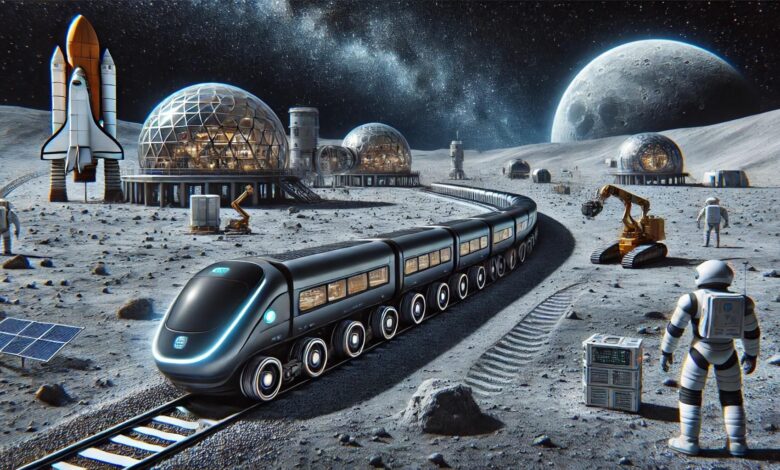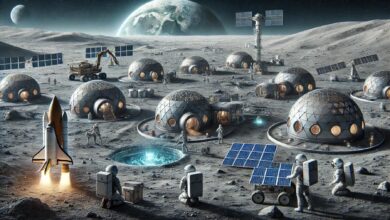Explained: Northrop Grumman’s Moon Train Funding and Concept
The Future of Lunar Exploration

Imagine a world where humans traverse the lunar surface, not just in rovers, but in trains gliding smoothly over the desolate landscape. This futuristic vision is inching closer to reality, thanks to the collaborative efforts of Northrop Grumman and DARPA. Their ambitious project aims to revolutionize lunar transportation through the development of a moon-based railroad network. This groundbreaking initiative promises to not only facilitate the movement of people and cargo but also lay the groundwork for a sustainable lunar economy.
Lunar exploration has always fascinated humanity. From the moment Neil Armstrong set foot on the moon in 1969, the idea of moon colonization and utilizing the moon’s resources has been a subject of both scientific inquiry and science fiction. As technology advances, what once seemed like an unattainable dream is now within the realm of possibility. The concept of a moon train is a testament to this progress, envisioning a future where transportation on the lunar surface becomes as commonplace as it is on Earth.
Northrop Grumman and DARPA: Pioneers of Lunar Infrastructure
Northrop Grumman, a global leader in aerospace and defense technology, has been selected by DARPA to spearhead the development of a lunar railroad system. This project is part of the LunA-10 Capability Study, a comprehensive 10-year initiative designed to explore and implement scalable systems for lunar infrastructure. The primary goal is to minimize the lunar footprint while providing essential commercial services for future lunar inhabitants.
Chris Adams, Vice President and General Manager of Strategic Space Systems at Northrop Grumman, emphasizes the transformative potential of this project:
“This investment in key developmental research keeps our technology at the forefront of next-generation solutions. With our proven experience in integrating complex systems and commercialized autonomous services, we will continue to create lasting change for a sustainable space ecosystem.”
The collaboration between Northrop Grumman and DARPA is not just about creating a functional transportation system; it’s about pioneering new frontiers in space exploration and establishing a foundation for future lunar colonization. By leveraging Northrop Grumman’s expertise in complex systems integration and DARPA’s visionary approach to technology development, this project aims to overcome the unique challenges of the lunar environment.
The Vision: A Lunar Railroad Network
The proposed lunar railroad network aims to transport humans, supplies, and resources across the moon’s surface, supporting both scientific and commercial ventures. This ambitious vision includes several key components:
- Defining Interfaces and Resources: Establishing the technical and logistical requirements for building a lunar rail network.
- Risk Assessment: Identifying potential cost, technological, and logistical risks associated with the project.
- Prototyping and Demonstration: Developing and testing prototypes to demonstrate the feasibility of a fully operational lunar rail system.
- Robotics Integration: Utilizing robotics for construction and maintenance tasks, such as grading, foundation preparation, track placement, alignment, and inspection.
The envisioned lunar railroad system will not only facilitate transportation but also serve as a critical infrastructure for lunar colonization. It will enable the efficient movement of materials necessary for constructing habitats, scientific research stations, and other essential facilities on the moon. By providing a reliable and scalable transportation solution, the lunar railroad will play a pivotal role in establishing a sustainable human presence on the moon.
The Strategic Importance of a Moon Train Funding
A lunar railroad system holds immense strategic value for the burgeoning space economy. By providing reliable transportation across the moon’s surface, it will enable the efficient movement of materials and personnel, crucial for both scientific exploration and commercial exploitation. The strategic importance of this project extends beyond mere transportation; it is about creating a new economic frontier in space.
Michael Nayak, Program Manager at DARPA’s Strategic Technology Office, underscores the project’s significance:
“A large paradigm shift is coming in the next 10 years for the lunar economy. To get to a turning point faster, LunA-10 uniquely aims to identify solutions that can enable multi-mission lunar systems. Imagine a wireless power station that can also provide comms and navigation in its beam.”
The development of a lunar railroad will also have profound implications for space logistics. It will streamline the supply chain on the moon, reducing the need for frequent launches from Earth and lowering overall mission costs. By creating an efficient and reliable transportation network, the lunar railroad will make it feasible to conduct large-scale moon mining operations, build permanent settlements, and establish a thriving lunar economy.
Technological Innovations and Collaborations
Northrop Grumman’s lunar railroad concept is part of a broader effort involving 14 companies, each contributing innovative technologies to the LunA-10 initiative. Notable projects include:
- GITAI’s Inchworm Robots: Designed for autonomous construction and maintenance tasks.
- Sierra Space’s Oxygen Extraction Technology: Enabling the production of essential life support resources from lunar regolith.
- ICON’s 3D Printing Using Lunar Regolith: Facilitating the construction of lunar habitats and infrastructure.
These collaborative efforts aim to overcome the unique challenges of the lunar environment and create a robust, sustainable lunar economy. The integration of these technologies will not only enhance the functionality of the lunar railroad but also provide complementary solutions for other critical aspects of lunar colonization.
The use of robotics and autonomous systems will be particularly crucial for the success of the lunar railroad. These technologies will allow for the efficient and precise construction of the rail network, minimizing the need for human intervention in the harsh lunar environment. Additionally, the integration of advanced materials and manufacturing techniques, such as 3D printing with lunar regolith, will enable the rapid and cost-effective construction of infrastructure on the moon.
Challenges and Future Prospects of a Train on the Moon
While the vision of a lunar railroad is tantalizing, it comes with significant challenges. The lunar environment is harsh and unforgiving, with extreme temperatures, radiation, and abrasive regolith. Developing technology that can withstand these conditions and operate autonomously is a formidable task.
Key Challenges Include:
- Environmental Hazards: The lunar surface experiences extreme temperature fluctuations, from -173°C at night to 127°C during the day. Radiation levels are also much higher than on Earth, posing risks to both equipment and human health.
- Regolith Abrasion: The lunar soil, or regolith, is highly abrasive and can damage mechanical components. Developing durable and dust-resistant technologies is essential for the longevity of the lunar railroad system.
- Autonomous Operations: Ensuring the reliable and autonomous operation of construction and maintenance robots in the challenging lunar environment requires advanced artificial intelligence and machine learning algorithms.
- Logistical Coordination: Coordinating the construction and operation of the lunar railroad with other ongoing and planned lunar missions will be a complex logistical challenge. Effective communication and collaboration between various stakeholders will be crucial.
However, the potential rewards are equally significant. A functioning lunar railroad could drastically reduce the cost and complexity of lunar operations, making sustained human presence on the moon feasible. It could also serve as a blueprint for similar systems on Mars and other celestial bodies, paving the way for humanity’s expansion into the solar system.
Economic and Commercial Potential of Moon Train
The development of a lunar railroad system presents significant economic and commercial opportunities. By facilitating the efficient transportation of materials and personnel, the lunar railroad will enable the establishment of a sustainable lunar economy. This, in turn, will create new markets and business opportunities, attracting investments from both public and private sectors.
Key Economic Benefits Include:
- Resource Extraction: The moon is rich in valuable resources, such as helium-3, rare earth elements, and water ice. The lunar railroad will enable large-scale mining operations, providing essential materials for both lunar and Earth-based industries.
- Infrastructure Development: The construction of habitats, research stations, and other facilities on the moon will drive demand for construction materials and services. The lunar railroad will streamline the supply chain, reducing costs and improving efficiency.
- Tourism and Recreation: As lunar infrastructure develops, space tourism will become a viable industry. The lunar railroad could provide transportation for tourists, offering unique experiences and generating significant revenue.
- Scientific Research: The moon offers unique opportunities for scientific research, from studying its geology and history to conducting experiments in a low-gravity environment. The lunar railroad will facilitate the movement of researchers and equipment, enhancing the scope and scale of scientific missions.
Scientific and Societal Impacts
Beyond its economic and commercial potential, the lunar railroad project will have profound scientific and societal impacts. By enabling sustained human presence on the moon, it will open new frontiers for scientific exploration and discovery. Additionally, it will inspire future generations to pursue careers in science, technology, engineering, and mathematics (STEM), fostering innovation and driving progress.
Key Scientific and Societal Impacts Include:
- Advancing Lunar Science: The lunar railroad will provide researchers with greater access to diverse regions of the moon, enabling comprehensive geological studies and enhancing our understanding of the moon’s history and formation.
- Inspiring Innovation: The challenges and opportunities presented by the lunar railroad project will inspire new technologies and innovations, driving progress in fields such as robotics, artificial intelligence, and materials science.
- Educational Opportunities: The project will provide valuable educational opportunities for students and researchers, offering hands-on experience with cutting-edge technologies and real-world applications of STEM principles.
- Global Collaboration: The development of a lunar railroad will require collaboration between governments, industries, and academic institutions worldwide. This collaborative approach will foster international cooperation and strengthen global partnerships in space exploration.
Future Prospects and Long-Term Vision
The development of a lunar railroad system is just the beginning of humanity’s journey towards sustainable space exploration and colonization. As technology advances and new innovations emerge, the possibilities for lunar infrastructure and transportation will continue to expand.
Future Prospects Include:
- Expansion to Other Celestial Bodies: The technologies and systems developed for the lunar railroad could be adapted for use on Mars and other celestial bodies. This would pave the way for human exploration and colonization beyond the moon.
- Integration with Lunar Habitats: The lunar railroad could be integrated with permanent lunar habitats, providing transportation for residents and supporting the development of self-sustaining lunar communities.
- Interplanetary Transportation Networks: As humanity expands its presence in the solar system, interplanetary transportation networks could be developed, connecting lunar and Martian colonies with Earth and other destinations.
- Sustainable Space Economy: The establishment of a sustainable lunar economy will serve as a model for future space economies, promoting the responsible and equitable use of space resources.
A New Era of Lunar Exploration with this Moon Train Funding
The Northrop Grumman moon train project represents a bold step towards a new era of lunar exploration and colonization. By investing in innovative technologies and fostering international collaboration, we are moving closer to making the dream of a sustainable lunar economy a reality. As these developments unfold, they will undoubtedly inspire future generations of scientists, engineers, and explorers to reach for the stars.
The journey to building a lunar railroad is just beginning, but with continued investment and ingenuity, the vision of trains traversing the moon’s surface may soon become a cornerstone of our extraterrestrial future. The potential impact of this project extends far beyond the moon, shaping the future of space exploration and establishing a foundation for humanity’s expansion into the cosmos.
Stay tuned as we track the progress of this groundbreaking initiative and explore the limitless possibilities it holds for humanity’s presence in space.
Sources:
- Northrop Grumman Corporation
- Zisk, Rachael. “The government is funding a project to put a train on the moon.”
- Pinkstone, Joe. “Nasa increases funding for railway on the moon.”
- Wall, Mike. “DARPA picks Northrop Grumman to develop ‘lunar railroad’ concept.”
- Hitchens, Theresa. “Northrop Grumman to conceptualize Moon trains for DARPA.”



